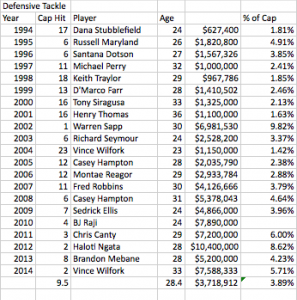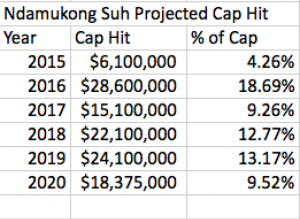From a salary cap perspective, this is the kind of stuff that really has interested me as someone who is striving to become an NFL agent. You have a client like Ndamukong Suh, granted there aren’t many like him, and he’s offered a contract of historical proportions, a six-year deal worth $114,375,000 with $59,995,000 fully guaranteed upon signing, but you have to have be able to advise him in a manner that is not only in his best interests financially, but you want him to be happy. If winning a Super Bowl is a player’s number one priority, then you need to help him construct a contract that gives him the best chance to do that.
Many of us have heard the study regarding the discovery that at around $75,000, your happiness level evens out and making more money doesn’t correlate to being happier. Those of you who follow me on Twitter (@ZackMooreNFL), know I love my comedian podcasts and guys like Joe Rogan talk about his first big money deal feeling like a weight was off his shoulders in that he knew he didn’t have to worry about where he was going to get money for his bills this month. It’s none of my business to tell another man (or woman) when they’ve made enough money, the market determines someone’s worth and that’s a beautiful thing. In the NFL marketplace, it’s up to an agent to understand his client and help him achieve his goals.
Now, no matter where Suh went, he was going to sign one of the richest defensive contracts in NFL history, but as his agent, what’s best for his happiness and in the long-term, does winning a Super Bowl increase the amount of money he can make? Is winning a Super Bowl and potentially being a part of a dynasty more important than an extra $15 million, when you’re already slated to make $100 million and you’ve already made about $65 million? I must say, I’ve never been put in that position, so who knows?
In my article comparing Manning and Brady (here), where I stated that Jason and I agreed that Manning and the Broncos should agree on a contract somewhere around $14 million, so he had a better chance at one more ring. With the cap going all the way up to $143.28 million, Manning dropped his cap number to $16 million which was a $4 million pay cut from what he was slated to make with the opportunity to earn it back through incentives, winning the AFC Championship and the Super Bowl.
I discussed in that article how winning one more Super Bowl would be worth more financially to Manning long-term than the extra money he would make in 2015 and at some point, I think that Suh and all players have to think about that.
Logan Mankins went from the eventual Super Bowl champion to the worst team in the NFL because he wouldn’t take a pay cut this season, part of your job as an agent is to make sure that you advice your client so that he will be happy with his career. I don’t know how Mankins feels about moving from the Pats to Bucs, but it’s up to an agent to know your client well enough to help him make the best financial and life choices.
I just got done writing about the 2014 Lions for my first completed part of the 2014 section of my coming e-book, Caponomics: Understanding NFL Roster Building through Super Bowl Champion Analysis. My main focus was on that Big 3 they had of Suh, Matthew Stafford and Calvin Johnson because they took up an absolutely mind-boggling 38.56% of their cap, which is 16.56% higher than the Super Bowl average for the Top 3. They’re so out of whack with the normal figures, that they are 10.73% higher than the 2002 Bucs who spent the most ever on their Top 3 at 27.83% on Warren Sapp, Brad Johnson, and Simeon Rice.
This is mainly due to Suh costing 3.77% more than Steve Young’s 1994 cap hit of 13.08%, which is the highest of the cap era. The average number one cap hit for a Super Bowl champion is 9.23%, so Suh is way off the average. Generally speaking, the quarterback is the most important position on the field, he has the most impact on the game, he touches the ball every play, so it’s very hard for me to comprehend how Suh could provide 129% of the value that Young provided during the best season of his career.
In terms of defensive tackles, Suh costs 7.03% more than the Sapp’s 9.82% hit in 2002. When you analyze the top DT cap charges for the last 21 champions, Suh costs 12.89% more than the average, an insane rate.
Figure 1: Average Cap Hit for Highest Paid Defensive Tackle on Super Bowl Champions
Something that is very interesting to me is that since the new CBA was signed, and even back to 2008, Super Bowl champions have all had a high paid defensive tackle. My theory, which I dig into a little bit in the book is that even though we’re in an age of passing and defensive tackles are primarily what I would call a run-game position, there are so few great defensive tackles, that maybe they’ve become a more important piece of success? Even so, the last four champs have had good pass rushers like Jason Pierre-Paul, Terrell Suggs, Michael Bennett and Rob Ninkovich.
Even when you account for the higher cost of DTs on recent champs, Suh still costs 10.71% more than the last four championship DTs. Simply put, Suh’s contract last year was so out of whack that it makes it almost impossible to win a championship. Compound that issue with the fact that Matt Stafford had a cap hit higher than every Super Bowl winning quarterback except Steve Young and that Calvin Johnson’s cap hit was 1.26% higher than the greatest receiver of all-time, Jerry Rice, and you realize that the Lions literally gave themselves no chance at the Super Bowl.
So now, Suh has taken his talents to South Beach and with him, he’s brought the curse of being a great player with a contract that cripples a team’s roster. As Jason said in this awesome interview with one of the greatest NFL media men of all-time Peter King, this year, Suh will “count for only $6 million against the cap, despite the annual contract value of $19.1 million. That leaves Suh with an average cap charge for the 2016-2018 seasons of $21.9 million. Quite honestly I am not sure how you compete in the NFL for a championship with those figures, especially for a defensive tackle.”
Jason then details some of the stuff I just talked about and estimates if the cap continues to rise at a rate of $10 million a season, then Suh’s cap situation isn’t going to get much easier. With a $28.6 million cap charge in 2016, Suh would take up 18.69% of a $153 million cap, which is more than double the 9.23% average for those number one cap hits. As Jason says, this is similar to the contract structure they used for Mike Wallace, which is something we all saw as an issue already.
In 2014, Mike Wallace took up 12.97% of the cap, 4.41% higher than Jerry Rice in 1994. Is Mike Wallace ever going to give you 152% of the value that Jerry Rice provided in his prime?
As Jason says, the only years that Suh’s cap number is acceptable are 2015, 2017 and 2020 if you estimate the cap to increase by $10 million each year and with a cap hit of 4.26% this season, they have a real advantage and could compete for a Super Bowl. It’s worth noting that the jump between 2013, 2014 and 2015 are the only three times that the cap has jumped about $10 million, I know that’s probably indicative of new revenue trends in the NFL. Below are the percentages of the cap that Jason and I project he will take up with this contract using that $10 million increase per year.
Figure 2: Suh’s Projected Cap Hit
This talk about Suh isn’t about how good Jason or I think a player is, I think the world of so many of these guys in the NFL, they’re immensely talented and more of them are good people than the media let on during the 2014 season (check out what Jared Allen is doing below Jason’s interview).
Having started a small business during my senior year of college in 2011 and having made a ton of mistakes to learn from, I’ve learned that everything in business comes down to the numbers, the financials. That’s largely what really drew me to caponomics and stoked a passion for it in me. We all want to grow up to be a General Manager or an owner of a team right? What better way to learn than through the cap.
And as an agent, you want your client to make his money, but you probably don’t want them to have a contract that they can never live up to and that ruins their team’s chances for a Super Bowl.
The Lions are probably better off with Haloti Ngata anyway. They’re still getting one of the three best interior defensive linemen in the NFL and considering that he’s a little older, if they get him to sign an extension, they’re going to get him for cheaper than what Suh would have cost them. Through my research for Caponomics, I’ve realized that strength based positions can have longer careers because they rely more on strength than speed. As a wide receiver enters his thirties, he typically begins to slow down a little bit, which is why the receivers who tend to elongate their careers seem to be the cerebral types, Jerry Rice, Reggie Wayne and so on.
As Joe DeFranco said in his Industrial Strength Podcast last week, the closer you are to the football, the stronger you have to be. At defensive tackle, it’s primarily strength, which can tend to almost naturally increase a bit when a player is heading into his thirties. For instance, even as a wide receiver, if I kept lifting like I was when I played football in college, I would continue to get stronger, my weight room numbers would continue to increase, etc. I believe that a run stopper like Ngata, if he stays healthy, could be very productive at the age of say 35 years old, he just turned 31 in January.
If you want to purchase The First Annual Caponomics: Understanding NFL Roster Building through Super Bowl Champion Salary Cap Analysis, please e-mail me at Caponomics@gmail.com, so that I can put you on our e-mail list for people interested in purchasing the book. If you join our e-mail list, I will send you the first chapter on the 2014 Lions and then the 2014 Patriots once it’s completed. I might even throw in a bonus Super Bowl champ in.
I’m currently in the process of getting some legal stuff handled for the book and then I can put the pre-order up on Amazon, otherwise, it would already be up there. Thanks for your support and feel free to send me any questions or ideas to that e-mail address.

